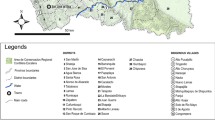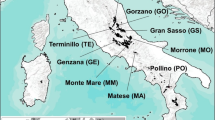Abstract
This study tests four hypotheses related to forest clearing over time in Ecuador’s northern Amazon: (1) a larger increase in population over time on a farm (finca) leads to more deforestation; (2) rates of forest clearing surrounding four primary reference communities differ (spatial heterogeneity); (3) fincas farther from towns/communities experience lower rates of forest clearing over time; and (4) forest clearing differs by finca settlement cohort, viz., by year of establishment of the finca. In this paper, we examine the relationship between forest clearing and key variables over time, and compare three statistical models—OLS, random effects, and spatial regression—to test hypotheses. Descriptive analyses indicate that 7–15% of forest area was cleared on fincas between 1990 and 1999; that more recently established fincas experienced more rapid forest clearing; and that population size and forest clearing are both related to distance from a major community. Controlling for key variables, model results indicate that an increase in population size is significantly related to more forest clearing; rates of forest clearing around the four major communities are not significantly different; distances separating fincas and communities are not significantly related to deforestation; and deforestation rates are higher among more recently established fincas. Key policy implications include the importance of reducing population growth and momentum through measures such as improving information about and provision of family planning services; increasing the low level of girls’ education to delay and reduce fertility; and expanding credit and agricultural extension services to increase agricultural intensification.


Similar content being viewed by others
References
Angelsen, A., & Kaimowitz, D. (2001). Agricultural technologies and tropical deforestation. Wallingford, England: CAB International.
Anselin, L. (1988). Spatial econometrics. Dordrecht, The Netherlands: Kluwer Academic.
Anselin, L. (1995). SpaceStat: A software program for the analysis of spatial data, Version 1.80. Morgantown WV: Regional Research Institute, West Virginia University.
Anselin, L., Bera, A. K., Florax, R., & Yoon, M. J. (1996). Simple diagnostic tests for spatial dependence. Regional Science and Urban Economics, 26(1), 77–104.
Anselin, L., Syabri, I., & Smirnov, O. (2003). GeoDa V0.9. Urbana IL: Center for Spatially Integrated Social Science.
Barbier, E. B. (2004). Agricultural expansion, resource booms and growth in Latin America: Implications for long-run economic development. World Development, 32(1), 137–157.
Barbieri, A., Bilsborrow, R. E., & Pan, W. K. (2005). Farm household lifecycles and land use in the Ecuadorian Amazon. Population and Environment, 27(1), 1–27.
Bilsborrow, R. E., Barbieri, A., & Pan, W. K. (2004). Changes in population and land use over time in the Ecuadorian Amazon. Acta Amazonica, 34(4), 635–647.
Bilsborrow, R. E., & Carr, D. L. (2001). Population and land use/cover change: A regional comparison between Central America and South America. Journal of Geography Education, 43, 7–16.
Bilsborrow, R. E., & Geores, M. (1995). Population change, land use and the environment: What can we learn from cross-national comparisons? In D. W. Pearce & K. Brown (Eds.), The causes of tropical deforestation (pp. 106–133). London, England: University College of London.
Boserup, E. (1965). The conditions of agricultural growth: The economics of agrarian change under population pressure. New York: Aldine Publishing Company.
Boserup, E. (1981). Population and technological change: A study of long term trends. Chicago IL: University of Chicago Press.
Browder, J. O., & Godfrey, B. J. (1997). Rainforest cities: Urbanization, development, and globalization of the Brazilian Amazon. New York: Columbia University Press.
Brush, S. B., & Turner, B. L. (1987). The nature of farming systems and views of their change. In B. L. Turner & S. B. Brush (Eds.), Comparative farming systems (pp. 11–48). New York: Guilford Press.
Carr, D. L. (2002). The role of population change in land use and land cover change in rural Latin America: Uncovering local processes concealed by macro-level data. In M. H. Y. Himiyama & T. Ichinoe (Eds.), Land use changes in comparative perspective (pp. 133–147). Enfield NH: Science Publishers.
Carr, D. L., Barbieri, A., Pan, W. K., & Iranavi, H. (2006a). Agricultural change and limits to deforestation in Central America. In F. Brouwer & B. A. McCarl (Eds.), Agriculture and climate beyond 2015: A new perspective on future land use patterns (pp. 91–108). Dordrecht, The Netherlands: Springer.
Carr, D. L., Pan, W. K., & Bilsborrow, R. E. (2006b). Declining fertility on the frontier: The Ecuadorian Amazon. Population and Environment, 28(1), 17–39.
CEPAR (2000). Encuesta Demografica y de Salud Materna e Infantil (ENDEMAIN III-99). Quito, CEPAR (Centro de Estudios de Poblacion y Paternidad Responsible), CDC.
CEPAR (2005). Encuesta Demografica y de Salud Materna e Infantil (ENDEMAIN IV-04). Quito, CEPAR (Centro de Estudios de Poblacion y Desarrollo Social), CDC.
Diggle, P., Liang, K. -Y., & Zeger, S. L. (1994). Analysis of longitudinal data. Oxford, England: Clarendon Press.
Diggle, P. J. (1988). An approach to the analysis of repeated measurements. Biometrics, 44, 959–971.
Escobal, J., & Aldana, U. (2003). Are nontimber forest products the antidote to rainforest degradation? Brazil nut extraction in Madre de Dios, Peru. World Development, 31(11), 1873–1887.
ESRI (1998). ArcView GIS Version 3.1. Redlands CA: Environmental Systems Research Institute.
ESRI (2002). ArcGIS. Redlands CA: Environmental Systems Research Institute.
Geist, H. J., & Lambin, E. F. (2002). Proximate causes and underlying driving forces of tropical deforestation. BioScience, 52(2), 143–150.
Hoshino, S. (2001). Multilevel modeling on farmland distribution in Japan. Land Use Policy, 18, 75–90.
INEC (1992). V Censo de Poblacion y IV de Vivienda; Resultados Definitivos. Quito, INEC.
INEC (2001). VI censo de poblacion y V censo de vivienda, 2001: resultados preliminares. Quito, Ecuador, INEC (Instituto Nacional de Estadistica y Censos).
Laird, N. M., & Ware, J. H. (1982). Random-effects models for longitudinal data. Biometrics, 38, 963–974.
Malthus, T. (1798). On population. New York: Modern Library (Random House).
Marquette, C. (1998). Land use patterns among small farmer settlers in the northeastern Ecuadorian Amazon. Human Ecology, 26(4), 573–598.
McCracken, S., Siqueira, A., Moran, E., & Brondizio, E. (2002). Land use patterns on an agricultural frontier in Brazil: Insights and examples from a demographic perspective. In C. H. Wood & R. Porro (Eds.), Deforestation and land use in the Amazon. Gainesville FL: University Press of Florida.
McLean, R. A., Sanders, W. L., & Stroup, W. W. (1991). A unified approach to mixed linear models. The American Statistician, 45, 54–64.
Mendenhall, W. (1968). Introduction to linear models and the design and analysis of experiments. Belmont CA: Duxbury Press.
Mittermeier, R. A., Mittermeier, C. G., Brooks, T. M., Pilgrim, J. D., Konstant, W. R., da Fonseca, G. A. B., & Kormos, C. (2003). Wilderness and biodiversity conservation. Proceedings of the National Academy of Sciences, 100(18), 10309–10313.
Moran, E., Brondizio, E., & McCracken, S. (2002). Trajectories of land use: Soils, succession, and crop choice. In C. H. Wood & R. Porro (Eds.) Deforestation and land use in the Amazon (pp. 193–217). Gainesville FL: University of Florida Press.
Murphy, L. (2001). Colonist farm income, off-farm work, cattle, and differentiation in Ecuador’s northern Amazon. Human Organization, 60(1), 67–79.
Myers, N., Mittermeier, R. A., Mittermeier, G., da Fonseca, G. A. B., & Kent, J. (2000). Biodiversity Hotspots for Conservation Priorities. Nature, 403, 853–858.
Pan, W. K., & Bilsborrow, R. E. (2005). The use of a multilevel statistical model to analyze factors influencing land use: A study of the Ecuadorian Amazon. Global and Planetary Change, 47(2–4), 232–252.
Pan, W. K., Walsh, S. J., Bilsborrow, R. E., Frizzelle, B., Erlien, C., & Baquero, F. (2004). Farm-level models of spatial patterns of land use and land cover dynamics in the Ecuadorian Amazon. Agriculture, Ecosystems & Environment, 101, 117–134.
Perz, S. (2001). Household demographic factors as life cycle determinants of land use in the Amazon. Population Research and Policy Review, 20(3), 159–186.
Perz, S., & Walker, R. (2002). Household life cycles and secondary forest cover among small farm colonists in the Amazon. World Development, 30(6), 1009–1027.
Pichón, F. J. (1997). Settler households and land use patterns in the Amazon frontier: Farm-level evidence from Ecuador. World Development, 25(1), 67–91.
Pingali, P., & Binswanger, H. P. (1988). Population density and farming systems: The changing locus of innovations and technical change. In R. Lee, W. B. Arthur, A. C. Kelley & G. Rodgers (Eds.), Population, food, and rural development. Oxford, England: Clarendon Press.
Polsky, C., & Easterling III W. E. (2001). Adaptation to climate variability and change in the US Great Plains: A multi-scale analysis of Ricardian climate sensitivities. Agriculture, Ecosystems & Environment, 85, 133–144.
Rubin, D. B. (1976). Inference and missing data. Biometrika, 63, 581–592.
Rudel, T., & Roper, J. (1996). Regional patterns and historical trends in tropical deforestation, 1976–1990. Ambio, 25(3), 160–166.
SAS (2003). SAS 9.1. Cary NC: SAS Institute Inc.
Searle, S. R. (1971). Linear models. New York: Wiley.
Stroup, W. W., Baenziger, P. S., & Mulitze, D. K. (1994). Removing spatial variation from wheat yield trials: A comparison of methods. Crop Science, 34, 62–66.
Swinton, S. M. (2002). Capturing household-level spatial influence in agricultural management using random effects regression. Agricultural Economics, 27, 371–381.
Turner, B. L., Hanham, R., & Portararo, A. (1977). Population pressure and agricultural intensity. Annals of the Association of American Geographers, 67, 384–396.
United Nations (2001). World population monitoring 2001: Population, environment, and development. New York, Population Division, Department of Economic and Social Affairs, United Nations Secretariat.
VanWey, L. K., D'Antona, A. O., & Brondizio, E. (2007). Household demographic change and land use/land cover change in Brazilian Amazon. Population and Environment, 28(3), 163–185.
Von Thünen, J. H. (1826/1966). Isolated state; an English edition of Der isolierte Staat. P. Hall (Ed.). New York: Pergamon Press.
Vonesh, E. F., & Chinchilli, V. M. (1997). Linear and nonlinear models for the analysis of repeated measurements. New York: Marcel Dekker Inc.
Walker, R., & Homma, A. K. O. (1996). Land use and land cover dynamics in the Brazilian Amazon: An overview. Ecological Economics, 18, 67–80.
Walker, R., Perz, S., Caldas, M., & Silva, L. G. T. (2002a). Land use and land cover change in forest frontiers: The role of household life cycles. International Regional Science Review, 25(2), 169–199.
Walker, R., Wood, C. H., Skole, D., Chomentowski, W., Walsh, S., & Crews-Meyer, K. A. (2002b). The impact of land titling on tropical forest resources. In S. Walsh & K. A. Crews-Meyer (Eds.), Linking people, place, and policy: A GIScience approach (pp. 131–153). Boston MA: Kluwer Academic Publishers.
World Bank. (1991). Forest sector review. Washington, DC: The World Bank.
Author information
Authors and Affiliations
Corresponding author
Rights and permissions
About this article
Cite this article
Pan, W., Carr, D., Barbieri, A. et al. Forest Clearing in the Ecuadorian Amazon: A Study of Patterns Over Space and Time. Popul Res Policy Rev 26, 635–659 (2007). https://doi.org/10.1007/s11113-007-9045-6
Published:
Issue Date:
DOI: https://doi.org/10.1007/s11113-007-9045-6




